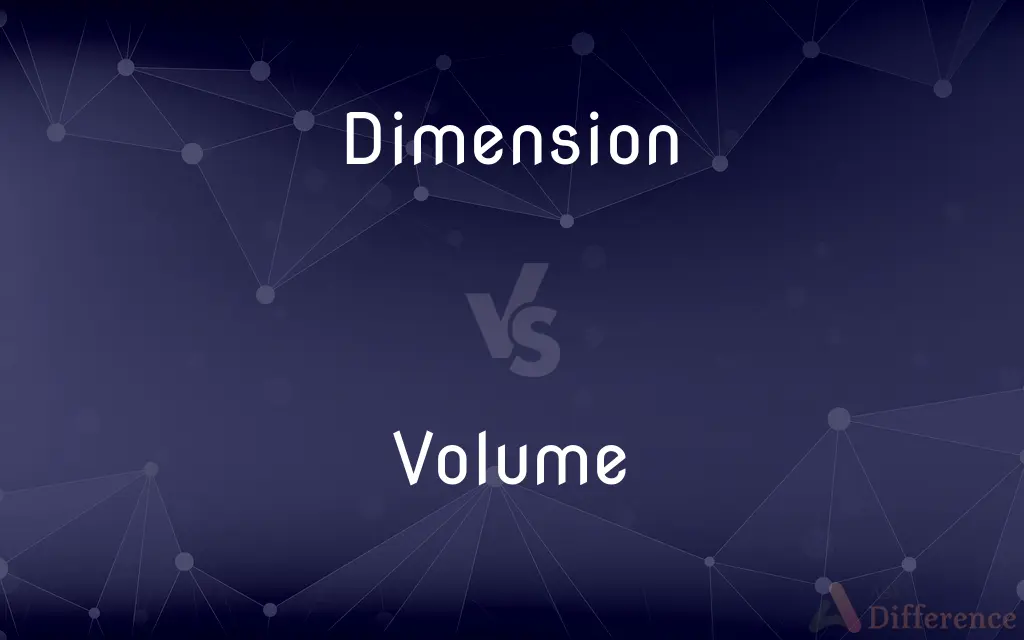Dimension vs. Volume — What's the Difference?
By Maham Liaqat & Fiza Rafique — Updated on March 30, 2024
Dimensions refer to measurements in space, while volume measures space occupied.

Difference Between Dimension and Volume
Table of Contents
ADVERTISEMENT
Key Differences
Dimensions represent measurements in space, such as length, width, and height, defining the size and shape of objects or spaces. They are fundamental in mathematics, physics, and everyday life, providing a way to describe the physical world in terms of distance and direction. Volume, on the other hand, measures the amount of space an object occupies, typically in cubic units. It's a key concept in geometry and physics, essential for understanding the properties of solids, liquids, and gases.
While dimensions are often used to describe the external boundaries of objects (e.g., the dimensions of a box), volume is used to quantify the internal space that an object contains. This distinction is crucial in fields like architecture, engineering, and shipping, where both the physical size of an object and the space it occupies or contains are important. Volume is directly related to the dimensions of an object, as it is calculated by multiplying relevant dimensions together (e.g., length × width × height for a rectangular prism).
Dimensions can vary in number based on the context; for example, a line has one dimension (length), a plane has two dimensions (length and width), and a solid has three dimensions (length, width, and height). In contrast, volume always refers to a three-dimensional measurement, emphasizing the space an object occupies. This makes volume a specific instance of how dimensions interact to define the physical space of an object.
In practical applications, dimensions are used to specify the exact size and orientation of objects and spaces, vital for construction, manufacturing, and design. Volume, however, is often used in contexts requiring the measurement of capacity, such as determining the amount of liquid a container can hold or the space available inside a storage area. This highlights how dimensions and volume serve complementary but distinct roles in describing and interacting with the physical world.
Both dimensions and volume are essential in understanding and manipulating the physical environment, but they emphasize different aspects of physical reality. Dimensions focus on the measurable extents of objects and spaces, while volume quantifies the three-dimensional space that matter occupies, highlighting the interplay between spatial measurements and physical presence.
ADVERTISEMENT
Comparison Chart
Definition
Measurements in space defining size and shape
Amount of space an object occupies
Units
Length (meters, feet), No specific units for dimensions alone
Cubic units (cubic meters, cubic feet)
Application
Describing size, shape, and orientation
Quantifying internal space, capacity
Related Concepts
Length, width, height
Calculation involves dimensions (l×w×h)
Practical Use
Construction, manufacturing, design
Measuring capacity, storage space
Compare with Definitions
Dimension
A measurement in one direction.
The dimension of the room’s length was 20 feet.
Volume
The capacity of a container.
The bottle has a volume of 2 liters.
Dimension
A mode of linear extension.
Points and lines are different dimensions in geometry.
Volume
The amount of space an object or substance occupies.
The volume of the box was 3 cubic feet.
Dimension
Aspects of size and shape.
The artist considered every dimension of the sculpture.
Volume
Quantity in three-dimensional space.
The volume of water displaced by the object was measured.
Dimension
Parameters defining boundaries.
The dimensions of the garden plot were set.
Volume
A measure of occupied space.
The gas expanded to double its original volume.
Dimension
Degree of extent.
The problem has many dimensions.
Volume
The extent of a three-dimensional figure.
They calculated the volume of the cylinder.
Dimension
In physics and mathematics, the dimension of a mathematical space (or object) is informally defined as the minimum number of coordinates needed to specify any point within it. Thus a line has a dimension of one (1D) because only one coordinate is needed to specify a point on it – for example, the point at 5 on a number line.
Volume
Volume is the quantity of three-dimensional space enclosed by a closed surface, for example, the space that a substance (solid, liquid, gas, or plasma) or 3D shape occupies or contains. Volume is often quantified numerically using the SI derived unit, the cubic metre.
Dimension
A measurable extent of a particular kind, such as length, breadth, depth, or height
The drawing must be precise in dimension
The final dimensions of the pond were 14 ft x 8 ft
Volume
A collection of written or printed sheets bound together; a book.
Dimension
An aspect or feature of a situation
We must focus on the cultural dimensions of the problem
Volume
One of the books of a work printed and bound in more than one book.
Dimension
Cut or shape (something) to particular measurements.
Volume
A series of issues of a periodical, usually covering one calendar year.
Dimension
A measure of spatial extent, especially width, height, or length.
Volume
A unit of written material assembled together and cataloged in a library.
Dimension
Often dimensions Extent or magnitude; scope
A problem of alarming dimensions.
Volume
A roll of parchment; a scroll.
Dimension
Aspect; element
"He's a good newsman, and he has that extra dimension" (William S. Paley).
Volume
The amount of space occupied by a three-dimensional object or region of space, expressed in cubic units.
Dimension
The least number of independent coordinates required to specify uniquely the points in a space.
Volume
The capacity of such a region or of a specified container, expressed in cubic units.
Dimension
The range of such a coordinate.
Volume
Amount; quantity:a low volume of business; a considerable volume of lumber.
Dimension
(Physics) A physical property, such as mass, distance, time, or a combination thereof, regarded as a fundamental measure of a physical quantity
Velocity has the dimension of distance divided by time.
Volume
OftenvolumesA large amount:volumes of praise.
Dimension
A realm of existence, as in a work of fiction, that is physically separate from another such realm
"Although it tells a grounded, political story free from aliens and alternate dimensions, the film remains packed to the brim with iconic ... characters." (Conner Schwerdtfeger).
Volume
The amplitude or loudness of a sound.
Dimension
To cut or shape to specified dimensions.
Volume
A control, as on a radio, for adjusting amplitude or loudness.
Dimension
To mark with specified dimensions.
Volume
A three-dimensional measure of space that comprises a length, a width and a height. It is measured in units of cubic centimeters in metric, cubic inches or cubic feet in English measurement.
The room is 9x12x8, so its volume is 864 cubic feet.
The proper products can improve your hair's volume.
Dimension
A single aspect of a given thing.
This film can be enjoyed on many dimensions - the script is great, the acting is realistic, and the special effects will simply take you aback.
Volume
Strength of sound; loudness.
Please turn down the volume on the stereo.
Volume can be measured in decibels.
Dimension
A measure of spatial extent in a particular direction, such as height, width or breadth, or depth.
Volume
The issues of a periodical over a period of one year.
I looked at this week's copy of the magazine. It was volume 23, issue 45.
Dimension
A construct whereby objects or individuals can be distinguished.
Volume
A bound book.
Dimension
(geometry) The number of independent coordinates needed to specify uniquely the location of a point in a space; also, any of such independent coordinates.
Volume
A single book of a publication issued in multi-book format, such as an encyclopedia.
The letter "G" was found in volume 4.
Dimension
(linear algebra) The number of elements of any basis of a vector space.
Volume
A great amount (of meaning) about something.
Dimension
(physics) One of the physical properties that are regarded as fundamental measures of a physical quantity, such as mass, length and time.
The dimension of velocity is length divided by time.
Volume
(obsolete) A roll or scroll, which was the form of ancient books.
Dimension
(computing) Any of the independent ranges of indices in a multidimensional array.
Volume
Quantity.
The volume of ticket sales decreased this week.
Dimension
A universe or plane of existence.
A machine that lets you travel to a parallel dimension.
Volume
A rounded mass or convolution.
Dimension
(transitive) To mark, cut or shape something to specified dimensions.
Volume
(economics) The total supply of money in circulation or, less frequently, total amount of credit extended, within a specified national market or worldwide.
Dimension
To specify the size of (an array or similar data structure); to allocate.
Volume
(computing) An accessible storage area with a single file system, typically resident on a single partition of a hard disk.
Dimension
In 24 Hours|page=268
Volume
(bodybuilding) The total of weight worked by a muscle in one training session, the weight of every single repetition summed up.
Dimension
Measure in a single line, as length, breadth, height, thickness, or circumference; extension; measurement; - usually, in the plural, measure in length and breadth, or in length, breadth, and thickness; extent; size; as, the dimensions of a room, or of a ship; the dimensions of a farm, of a kingdom.
Gentlemen of more than ordinary dimensions.
Volume
(intransitive) To be conveyed through the air, waft.
Dimension
Extent; reach; scope; importance; as, a project of large dimensions.
Volume
(transitive) To cause to move through the air, waft.
Dimension
The degree of manifoldness of a quantity; as, time is quantity having one dimension; volume has three dimensions, relative to extension.
Volume
(intransitive) To swell.
Dimension
A literal factor, as numbered in characterizing a term. The term dimensions forms with the cardinal numbers a phrase equivalent to degree with the ordinal; thus, a2b2c is a term of five dimensions, or of the fifth degree.
Volume
A roll; a scroll; a written document rolled up for keeping or for use, after the manner of the ancients.
The papyrus, and afterward the parchment, was joined together [by the ancients] to form one sheet, and then rolled upon a staff into a volume (volumen).
Dimension
The manifoldness with which the fundamental units of time, length, and mass are involved in determining the units of other physical quantities.
Volume
Hence, a collection of printed sheets bound together, whether containing a single work, or a part of a work, or more than one work; a book; a tome; especially, that part of an extended work which is bound up together in one cover; as, a work in four volumes.
An odd volume of a set of books bears not the value of its proportion to the set.
Dimension
The magnitude of something in a particular direction (especially length or width or height)
Volume
Anything of a rounded or swelling form resembling a roll; a turn; a convolution; a coil.
So glides some trodden serpent on the grass,And long behind wounded volume trails.
Undulating billows rolling their silver volumes.
Dimension
A construct whereby objects or individuals can be distinguished;
Self-confidence is not an endearing property
Volume
Dimensions; compass; space occupied, as measured by cubic units, that is, cubic inches, feet, yards, etc.; mass; bulk; as, the volume of an elephant's body; a volume of gas.
Dimension
One of three cartesian coordinates that determine a position in space
Volume
Amount, fullness, quantity, or caliber of voice or tone.
Dimension
Magnitude or extent;
A building of vast proportions
Volume
The amount of 3-dimensional space occupied by an object;
The gas expanded to twice its original volume
Dimension
Indicate the dimensions on;
These techniques permit us to dimension the human heart
Volume
The property of something that is great in magnitude;
It is cheaper to buy it in bulk
He received a mass of correspondence
The volume of exports
Dimension
Shape or form to required dimensions
Volume
Physical objects consisting of a number of pages bound together;
He used a large book as a doorstop
Volume
A publication that is one of a set of several similar publications;
The third volume was missing
He asked for the 1989 volume of the Annual Review
Volume
A relative amount;
Mix one volume of the solution with ten volumes of water
Volume
The magnitude of sound (usually in a specified direction);
The kids played their music at full volume
Common Curiosities
Can dimensions apply to abstract concepts?
Yes, dimensions can also refer to degrees of complexity or aspects of situations, not just physical space.
What is the primary difference between dimension and volume?
Dimensions refer to measurements defining size and shape, while volume measures the space an object occupies.
Can volume exist without dimensions?
No, volume is calculated based on the dimensions of an object and thus cannot exist without dimensions.
Is volume only relevant for solids?
No, volume is also relevant for liquids and gases, as it measures the space they occupy.
How are dimensions used in real life?
Dimensions are used to specify the size, shape, and orientation of objects and spaces in construction, manufacturing, and design.
How do dimensions affect volume?
The volume of an object is directly affected by its dimensions, as volume is calculated by multiplying relevant dimensions together.
Why is volume important?
Volume is important for determining the capacity of containers, the space available for storage, and the amount of material needed to fill spaces.
How do professionals use dimensions and volume differently?
Professionals in fields like architecture and engineering use dimensions to design and build, while volume is often used for capacity and storage planning.
What units are used for measuring dimensions and volume?
Dimensions are measured in units of length (e.g., meters, feet), while volume is measured in cubic units (e.g., cubic meters, cubic feet).
What makes dimensions fundamental in physics?
Dimensions are fundamental in physics for describing the properties of space and objects, helping to understand the universe's structure.
Can volume indicate the properties of a substance?
Yes, by measuring the volume of a substance, you can infer properties like density when combined with mass measurements.
Why is understanding volume crucial in shipping and logistics?
Understanding volume is crucial for optimizing space usage and determining shipping costs based on the space items occupy.
How do dimensions and volume interrelate in product design?
In product design, dimensions define the product's size and shape, while volume may determine its capacity or the space it will occupy.
Do dimensions have a limit in theoretical physics?
In theoretical physics, dimensions can extend beyond the three we experience daily, as proposed in theories like string theory.
How do dimensions relate to geometry and mathematics?
Dimensions are a core concept in geometry and mathematics, used to describe and calculate the properties of shapes and spaces.
Share Your Discovery

Previous Comparison
Symbol vs. Legend
Next Comparison
Diaper vs. DipperAuthor Spotlight
Written by
Maham LiaqatCo-written by
Fiza RafiqueFiza Rafique is a skilled content writer at AskDifference.com, where she meticulously refines and enhances written pieces. Drawing from her vast editorial expertise, Fiza ensures clarity, accuracy, and precision in every article. Passionate about language, she continually seeks to elevate the quality of content for readers worldwide.














































